Our thank you sale is on now - save 10% off any item, or 15% off two or more!
- Home
- Germany's romantic road
Germany's Romantic Road: The Popular Tourist Route
By: Lydia Fulson / Writer, Pyrography Artist, Thrill Seeker, and Traveler
Germany's Romantic Road, “Romantische Straße,” is one of the most popular ways to see some of the biggest main attractions and picturesque towns that Germany has to offer. Let's see what makes it so popular.
The Romantic Road covers 460 kilometers of ground between Würzburg and Füssen in Germany's beautiful southern landscapes. What was once used as a trade route is now the path to hundreds of travel sights and views.
The road has become a significant source of income for the German people working along the route. Small-town shops, restaurants, and attractions thrive year-round. There is something to see, no matter the season.
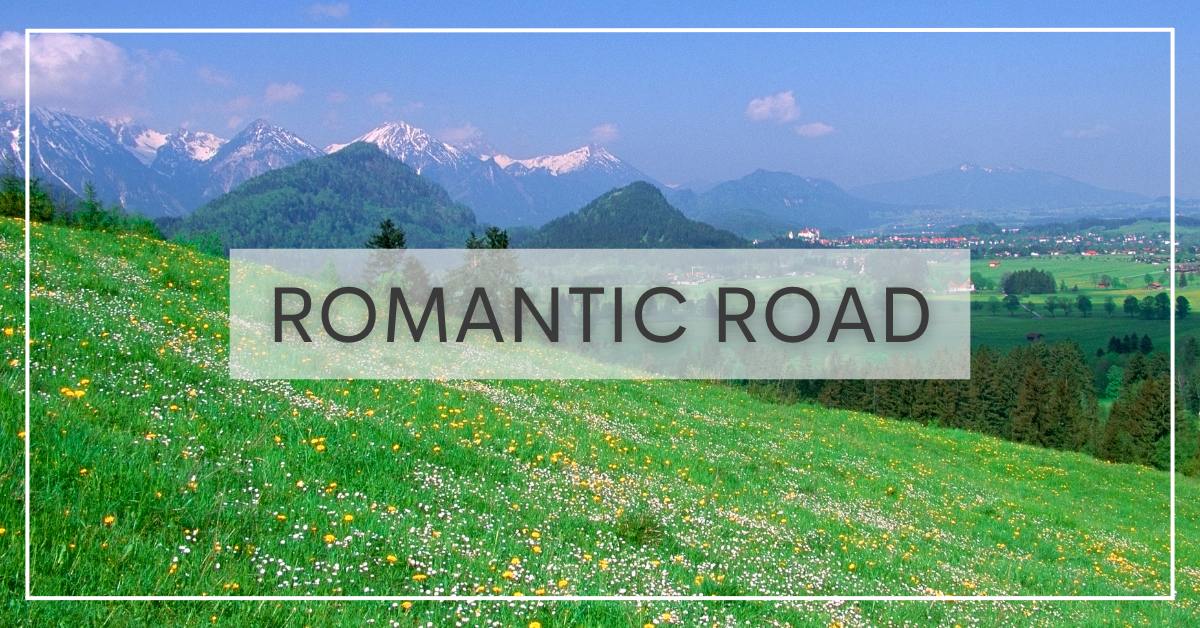
On this page:
History of the Romantic Road
The Romantic Road was invented in the 1950s to help boost tourist numbers in areas that weren't getting as much income as the bigger cities, like Berlin. The smaller towns were struggling economically to keep their livelihoods from dying out. Marketing wasn't exactly as good back then as it is now. The Second World War left Germany's tourist population completely diminished to almost zero.
First, the friends and relatives of American soldiers stationed in Bavaria came to see what the raving was about. The upgrades made to fix up the touristy areas, the new shops, and other alterations didn't go unnoticed. With the help of newspapers, brochures, and word of mouth, the Romantic Road route became a hit, tourists started flooding in, and these traditional and historical places were bustling with life once more.
The route is bustling with opportunities, from Christmas markets to towering cathedrals and medieval castles to the tiny hidden markets and tourist shops selling the finest German souvenirs.
Traveling the Route
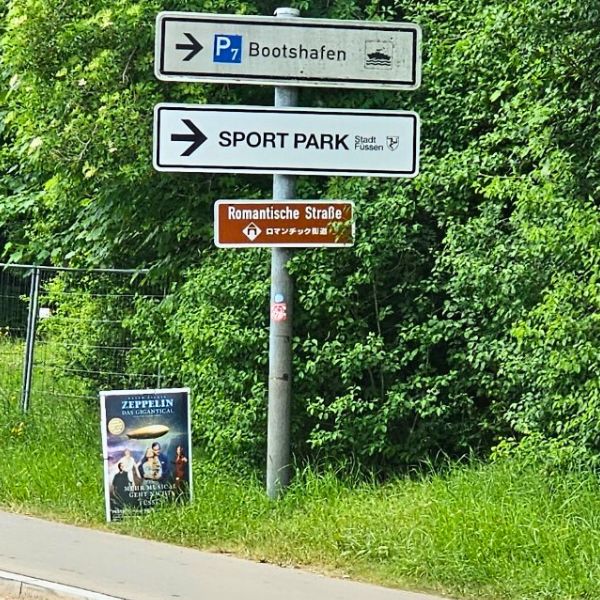 Oma snagged this perfect pic of the famous Romantische Straße sign on our drive through Schwangau! Good eye, Oma.
Oma snagged this perfect pic of the famous Romantische Straße sign on our drive through Schwangau! Good eye, Oma.Driving by car is the best option when traveling on the Romantic Road. There are dozens of rental car stops along the route. But if you're nervous about being responsible for a vehicle that isn't yours … in a different country … an understandable reason, trains are available. Trains run between cities along Germany's Romantic Road. Another great option is a bus tour. There aren't any bus tours that travel the entire length of the road, but a few cover different sections of it.
There are so many options for tours along the romantic road. Check them out and find the ones that fit you and accommodate you best.
As someone who took part in a tour, they are worth it. Everything is done for you, so there's no stress needed. Many offer accommodations like hotels, pickup and drop off at hotels, private guides, meals, and more. The opportunity to make new friends from all over Germany, even the world, is amazing as well.
Starting from one end to another, let's explore a couple of hidden gems and famous landmarks of the Romantic Road, starting in Würzburg.
Würzburg & What to See
The Romantic Road starts in northern Bavaria in the town of Würzburg. Known as one of the wine capitals of Germany, Würzburg is a romantic and colorful hidden gem.
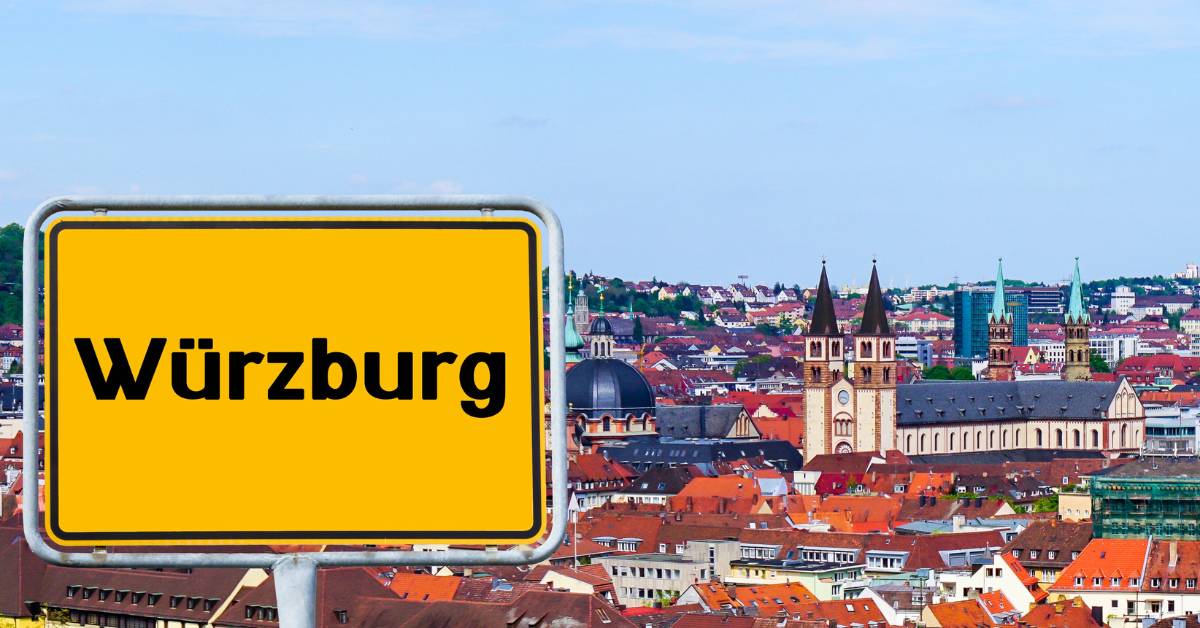
Visit Marktplatz:
The market square is a mega tourist attraction in Würzburg. The markets held here are always full, except on Sundays, when everything but cafés are closed.
The markets host an abundance of vendors, some local and some from further German states. Vendors come to sell their produce, seasonally, homemade goods and jewelry, wine, ice wine, and more. In the winter months, the annual Christmas markets are the biggest hit.
When does the market square Christmas market start this year?
The market will open from November 28 to December 23, 2025.
Christmas markets in Germany are one of the biggest reasons for tourism in the winter. Wurzburg Christmas market is smaller than the famous Nuremberg market and its massive Oktoberfest - worthy popularity. But it is a big event for locals from Wurzburg and neighboring cities.
The half-timbered houses with peaks covered in fresh white snow strung with white lights make for the most stunning sight. Live bands play Christmas tunes, new and old, and steaming hot Gluehwein (hot mulled wine) awaits you.
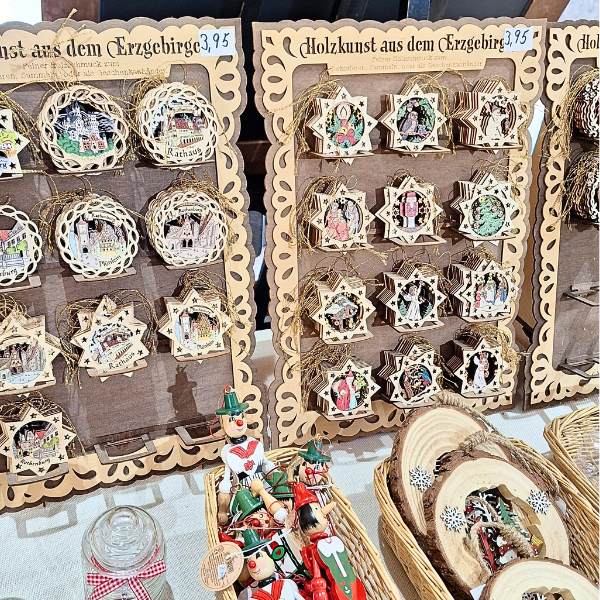 I found these wooden ornaments in Rothenberg, but saw them in a handful of other cities we visited as well.
I found these wooden ornaments in Rothenberg, but saw them in a handful of other cities we visited as well.Stroll from vendor to vendor and grab some intricate wooden ornaments. These are a staple at Christmas markets in Germany. You'll probably see thousands! So much preparation goes into markets like these. Lights and wreaths are strung from lantern to lantern, and everyone is bustling and laughing with the joy of the season.
Visit The Wurzburg Residence:
Open: April through October daily 9 am – 6 pm
November through March daily 10 am – 4:30 pm
The UNESCO World Heritage Site is a masterpiece in architecture and detail. The second you walk into the bishop's residence, you'll be blown away by the impressive staircase and artistry lining every inch of the walls.
Almost completely destroyed in 1945, the residence was restored to this remarkable building. The chapel, staircase, and manicured gardens are all sights to see in Würzburg. English tours are available daily.
Visit Wurzburg Cathedral, aka Würzburger Dom:
In all of its Romanesque glory.
It's the fourth-largest Roman-style cathedral in all of Germany. Nicknamed the Saint Kilian Cathedral, it was built in 1040 in Roman architecture. The cathedral had certain parts remodeled into a Gothic style and some even into a Baroque look in later years. Now, it stands as a mix of architectural styles, but is one of the biggest attractions of Würzburg. The dome and towers are a popular photo backdrop for tourists.
The cathedral features a 1969 organ and 20 bells!
Open: Monday- Saturday from 9:30am-5:30pm
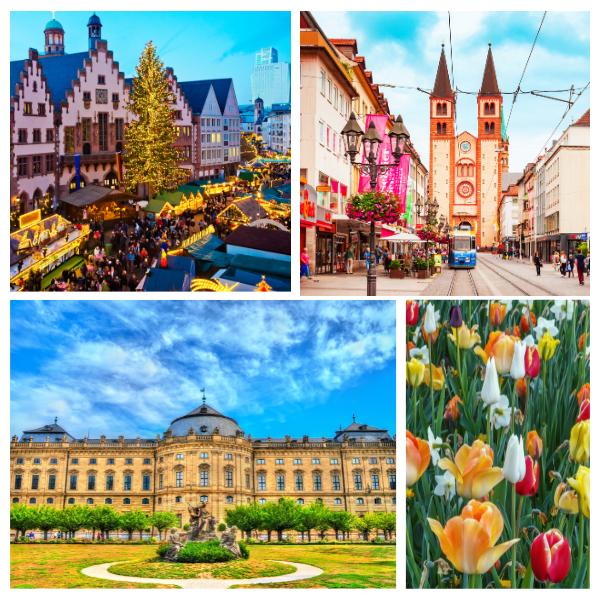 See these beautiful sights for yourself and visit Würzburg today!
See these beautiful sights for yourself and visit Würzburg today!There are all-day tickets available for public transit. The public transit options in Würzburg are buses, trams, and taxis. The city has 18 bus routes and five tram lines. The trams make loops around the city all day, every day.
Buying an all-day transit ticket is a great idea when visiting a city. It saves time having to pay every time you wait for a bus or tram and leaves more time to see more sights and cathedrals!
These tickets only cost 4 euros. Bike rentals are also available to enjoy a leisurely ride along the River Main.
Let's check out another hidden gem along the Romantic Road route.
Wertheim & What to See
Wertheim is a medieval town where Main and Tauber connect in Baden-Württemberg. Its scenic hiking trails and impressive architecture make for a lovely stop on your Romantic Road tour.
Did you know that due to rising water levels during heavy rainfall, Wertheim raised its streets over a meter high to protect the homes and streets? Flood gates were also built around the water's edge to help minimize flooding. Wow!
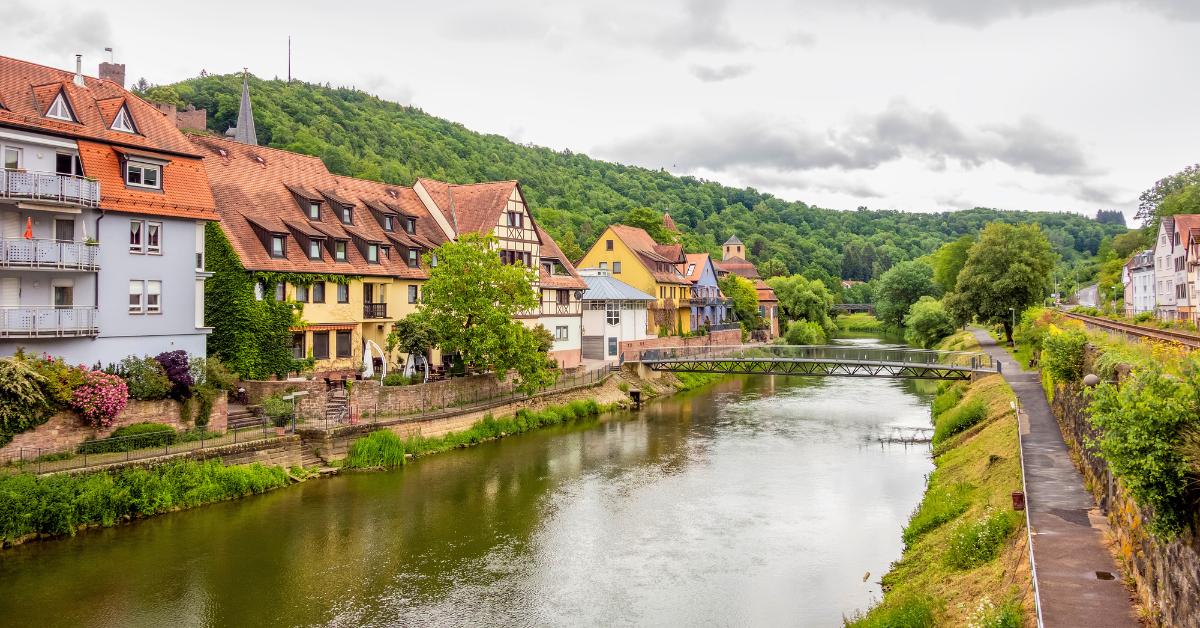
Visit Wertheim Castle:
The castle has that classic style to satisfy any history lover and architecture admirer. The castle took damage during the Thirty Years' War, but actually met its fate due to a powder explosion caused from the inside in the early 16th century.
A worker forgot to put out a candle, the flame met with the gunpowder ... and BOOM. A massive part of the castle was destroyed, but servants and the duke's family scrambled to save some of its artifacts that you can see today in the rebuilt castle.
The 12th-century royal castle features a restaurant serving the best of the best. After taking lots of pictures wandering the castle ruins, along with the new additions, sit and relax with a cool drink and a tasty authentic German meal.
Climb to the top of the flag tower for the most indescribable view of the old town. Tour time allowing, do try to stick around Wertheim at night to see the castle lit up like a fairy tale.
Visit The Spitzer Turm:
Known as the 'Leaning Tower of Wertheim' … due to over 800 years of flooding, the stone and sandstone base started to erode and cause the tower slowly to begin leaning.
The tower served as a watch tower and a prison tower for drunkards. The base was built in 1180 and the finishing tower top was added in the 1400s. This tourist attraction is a must-see when visiting Wertheim along the Romantic Road … before it leans a bit too far over.
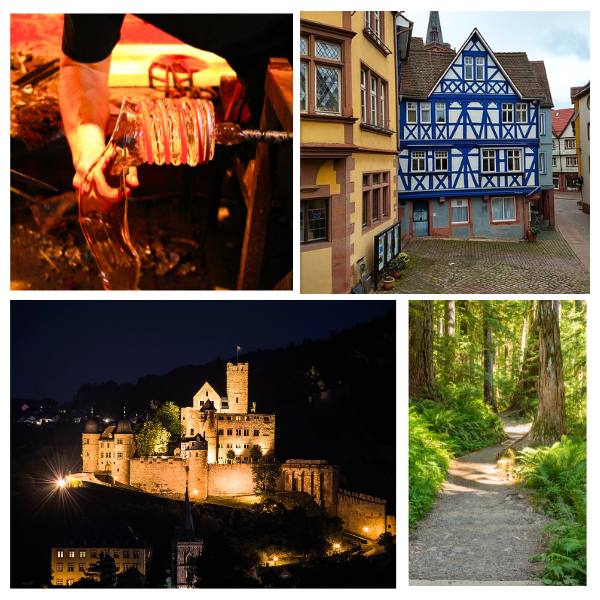
Visit Wertheimer Glaskunst:
Calling all artists! Here's a shop displaying an assortment of handmade glass items, ranging from bowls to vases to display pieces and jewelry. The glass items are all made within the shop, and demonstrations and shows are performed for tourists to see just how it's done! The professional glassblowers put on a great show for everybody.
The items are all handmade pieces of beauty and color. There's nothing more unique than coming to Wertheim and having a custom piece of glass heated, spun, and blown to perfection just for you to take home to remember it all by.
Visit trails:
Wertheim has loads of scenic trails suited for any type of hiker. The beginner, the leisurely, the intense, the biker, the stop-and-take-photos-of-mushrooms-every-five-minutes hiker … Guilty…
The most popular trail is from Wertheim along the Tauber Valley and is a 6.8 km loop. This route has some incline, but is generally an easy one to take your time and not be out of breath the whole time. Without stops and photo ops, this hike takes about 1hr 45 minutes to complete the loop.
It's not a race; take your time! Do a bit of research beforehand to learn the difficulty of each trail to find the perfect one for you.
Rothenburg & What to See
The town of Rothenburg ob der Tauber is a quaint and old-style town in Mittelfranken (middle Franconia), Bavaria, along the peaceful Tauber River.
Rothenburg is one of the most well-preserved medieval towns in Germany. Its history is sweet, and its people are just as such. While visiting Rothenburg, there were at least 50 souvenir shops on just one stretch of cobblestoned street. This cute and romantic town is full of old-world charm.
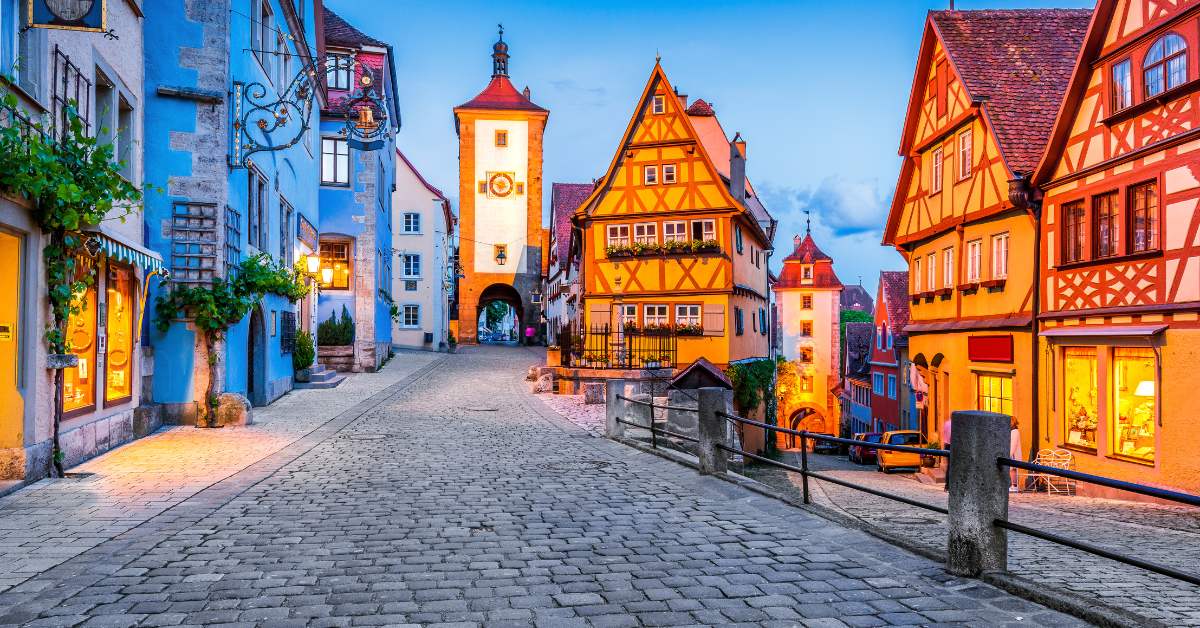
Visit Teddyland:
The famous teddy bear shop. This shop is the largest teddy shop in Germany and will make your childhood dreams come true. Teddy-themed portraits, stuffed bears, ornaments, blankets, keychains, statues, bags, you name it, they've got a bear on it.
I'll admit, I went a little gung-ho in this shop. As a teddy lover, I spent so long gushing over how many I wanted to buy. That was the only time I've ever regretted only bringing a carry-on. Maybe it was a blessing in disguise, or I would've bought myself a few too many bears to bring home.
The entrance has the best greeter, a giant teddy, and if you look to the left, a bench with a teddy on it for a photo op! Look up too. Above the shop sign are two sweet bears sitting on a swing. Walking into the store, you'll be surrounded by the cutest, cuddliest faces. Inside are massive trees, decorated floor to ceiling with bears on the branches, and climbing and hanging out in the hollowed-out trunk. Release your inner child and go visit Teddyland!
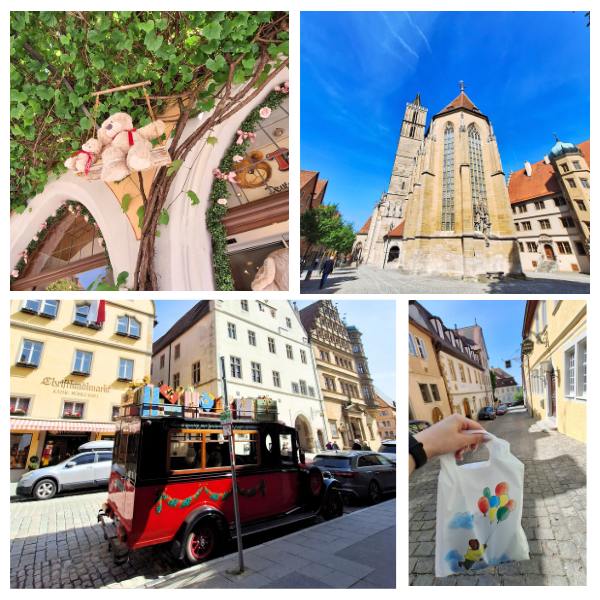 I took these pictures while wandering through Rothenburg. This was by far one of my favorite stops along the route.
I took these pictures while wandering through Rothenburg. This was by far one of my favorite stops along the route.Visit St. James (St Jakob) church:
This is a 13th-century church with a 5,500 pipe organ and impressive towers. Organ concerts are held throughout the year, and audio guides are available for tourists to learn about the rich church's history.
The Altar of Sacred Blood is found here, a sight that people will travel great distances to see. This is one of those hidden gem moments that you could see for yourself.
Visit Käthe Wohlfahrt’s Christmas Village!:
This Christmas store is a hard one to miss with the Käthe Wohlfahrt Gift Express, an old, bright red car with gifts on the roof, parked out front. This car, plus the fantastic displays and array of items for sale inside, put this shop on the map.
Anything holiday-themed, Käthe Wohlfahrt's has it. Inside are over-the-top, amazing displays of lights, trees, giant nutcrackers, ornaments, figurines, huge Christmas villages, and a showstopping 16-foot Christmas tree. This is a great stop along the Romantic Route for gifts and unique decorations, unlike anything you've seen before.
Open year-round and located right down the street from the Rothenburg market square, this is a wunderbar addition to your travels. Don't stress if you see something a bit too big for that little suitcase you brought along, like I did. You can order from their website, and the shop will ship it right to you and package it well to keep your new souvenir safe and sound on its journey to you.
Harburg & What to See
Harburg made it onto the route for a good reason. Look how stunning and scenic this countryside town is. It may be small, but it offers so many relaxing opportunities to see things other than bustling business. No one's in a hurry in Harburg. Just take in that fresh air and take in what's around you.
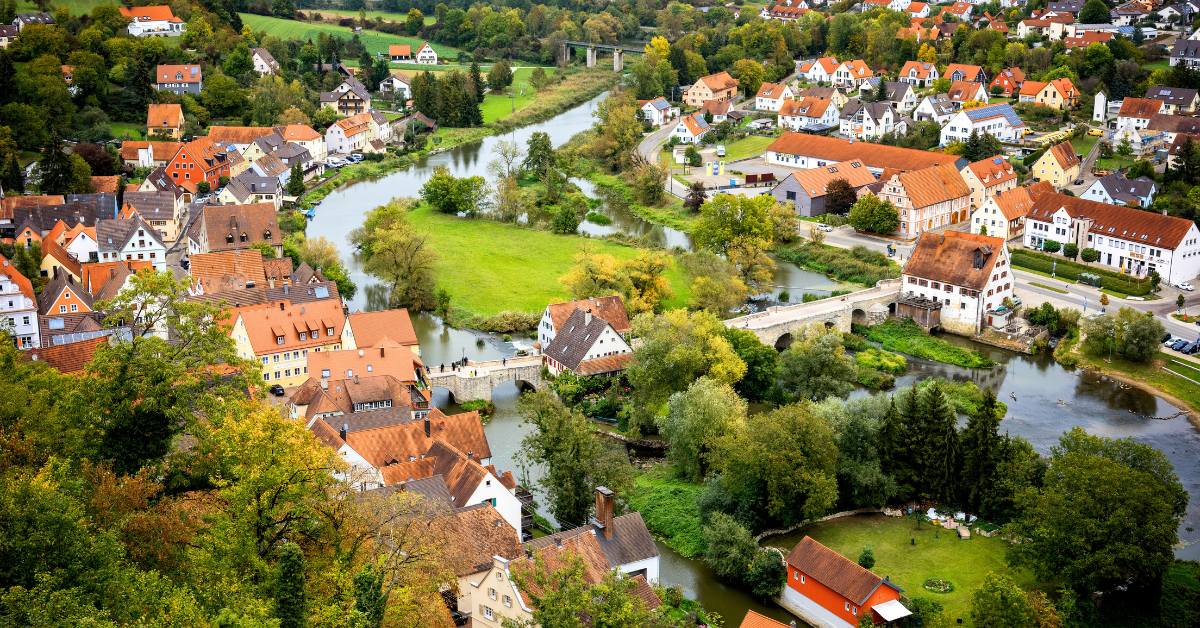
Visit Harburg Castle:
The town has a beautiful hilltoper. The historic castle of Harburg stands tall over the town showing off as a stunning historic landmark for tourists traveling the romantic route.
This military stronghold castle complex offers tours in English and German, with parking close by, leaving only a short walk to enter. Harburg Castle is one of the oldest standing castles in southern Germany, and many say one of the strongest. There is so much to see scattered along the castle grounds and the famous courtyard. One will want to book a tour beforehand to get a good informative look at the inside. Walk the castle walls and take in the view of Harburg below before grabbing a bite at the complex's restaurant. Don't miss this hidden gem.
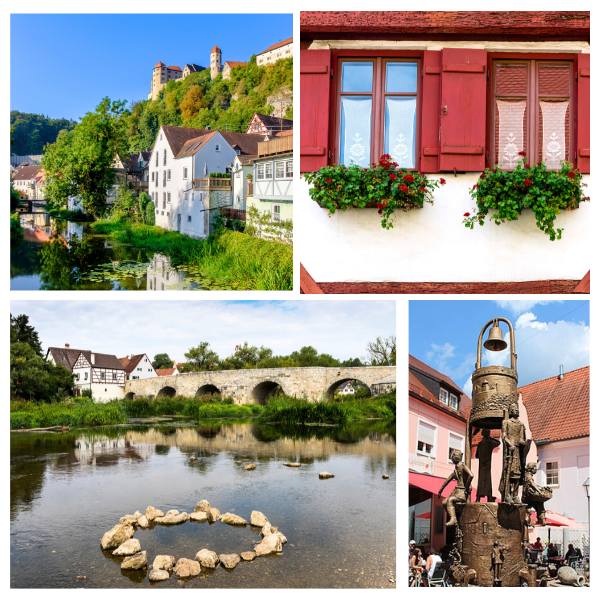 Welcome to the quaint and quiet city of Harburg.
Welcome to the quaint and quiet city of Harburg.Visit the Old Stone Bridge:
The Steinerne Brücke is a 12th-century bridge connecting the old and new parts of Harburg. The bridge suffered damage to two of its arches during World War II, but was quickly repaired and still stands as a symbol of remarkable architecture. They don't build things like they used to, that's for sure!
Crossing the bridge leads right into Harburg's city center and famous market square, where one can find local shops, farm fresh produce, and more.
Nördlingen & What to See
Visit Nördlingen, the meteorite town in Bavaria! If you're into astronomy and geology, this is the place to learn about. I'm just going to throw a random fun fact at you to get you excited about this lovely city. Did you know that ariel scenes of Nördlingen were featured in Willy Wonka and the Chocolate Factory?
The city of Nördlingen was built into a meteor crater created by a meteor, 15 million years old that was traveling at speeds of 70,000 km/h. The massive impact created a 25-km diameter circular depression in the ground. The impact crater has been named the Nördlinger Ries.
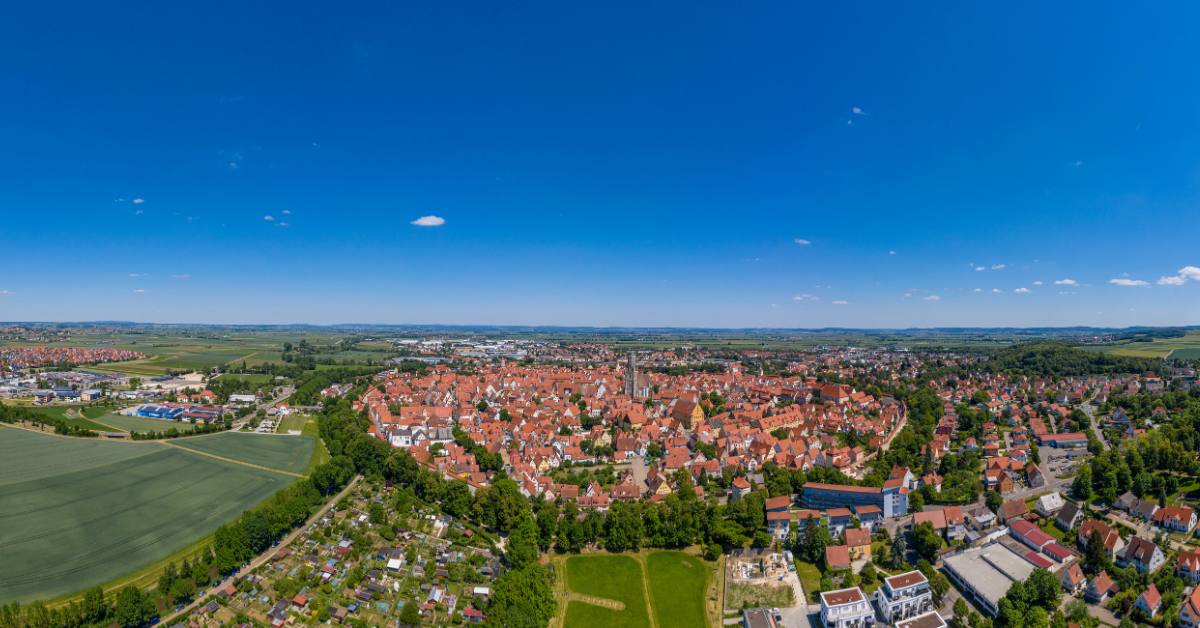
Visit The Ries Crater Museum (Rieskrater Museum Noerdlingen):
Here's the best spot to learn the history and details about the crater impact, the building of the city within, and what the meteor caused. Learn about vegetation regrowth and the hidden secret about Nördlingen.
What many visitors to the city don't know is that when this meteor hit the earth, it hit a graphite deposit, so on impact, it shot out 72,000 tons of tiny diamonds! Almost every original stone house in the city has diamonds in its stone exterior. Wow!
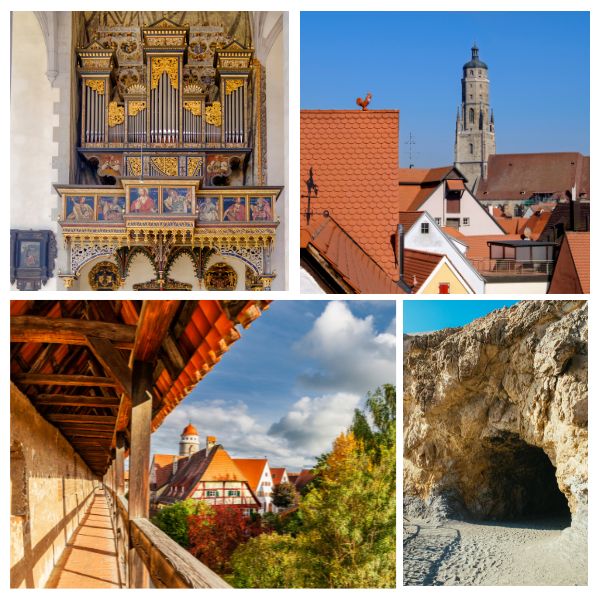 Spelunking time! How many times in your life can you say that you got to stay in a crater made city?
Spelunking time! How many times in your life can you say that you got to stay in a crater made city?Visit Ofnethöhlen:
Time to take a hike to the caves! Calling all spelunkers! From Nördlingen, head to the remains of the Roman estate, Römischer Gutshof im Maienbachtal. Here one can park and walk 10 minutes up the hill to the Ofnethöhlen caves.
Thousands of years before the city was built, the Nördlinger Ries crater circle was once full of water, creating a lake that caused erosion from the constantly changing water levels. But as the climate got warmer, the water would dry up, leaving thousands of fossils and caves behind.
Located on the outer edge of the crater are the Ofnethöhlen caves. Two small and one larger caves are ready for you to explore and debunk their history. They were first discovered in 1875 by a priest from Stuttgart, Nördlinger's neighboring city. While studying, he unearthed stone tools, and bones made into weapons, dating back 5,000 to 7,000 years. In later exhibitions, remains of a tribe were uncovered. And now, the cave can be visited and has informative signs by the entrance for more information on further expeditions.
Visit St. George’s church:
The 14th-century church is worth the visit. The gothic style church is just one of the city's historic landmarks. The tower, named Daniel, is the most eye-catching part. Once inside the church, one can climb to the viewpoint of the tower, but only if you're feeling like a workout. It's over 300 steps to the top! The view from here is spectacular. One can see the perfect circle edge of the crater surrounding the city.
Nördlingen really is the circle within the circle.
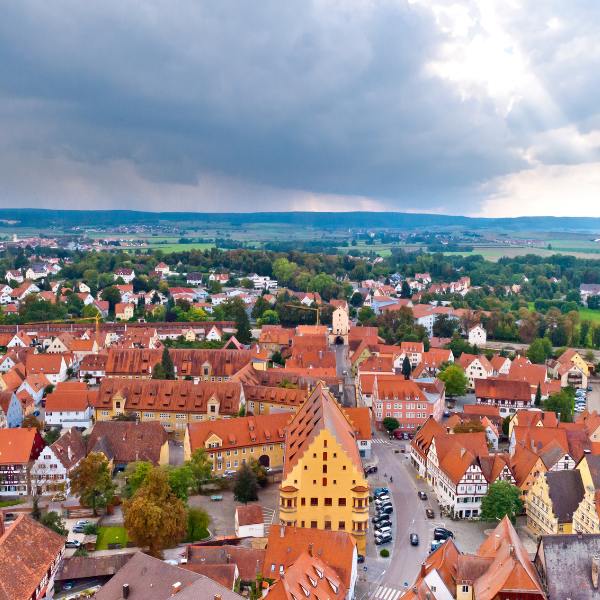 Check out that crater edge!
Check out that crater edge!This church has gone through three organs since 1945. The first one, the Steinmeyer organ, was destroyed during an enemy bombing. Then again, the second was ruined by a fire in 1974, destroying the organ built in the1600s. Now, its third one plays on and fills the church with its beautiful tune.
Walk the City Wall:
Nördlingen is one of the three cities left in Germany that still have intact city walls. Rothenburg is another. When within the city, staircases can be seen along the lining city wall. Walk up any of these sets of stairs to walk around the top of the city wall! You can get a good view of St. George's church from here.
Augsburg & What to See
Founded in 15 BC by the Romans, Augsburg is now part of the Romantic Road due to its many popular sites and stops. It's a massive university town with nearly ten times the population of Nördlingen.
Much like Würzburg, Augsburg holds an annual Christmas market in the market square right before the famous town hall. Here, attendees can feast on local Christmas treats, listen to the angel choir, buy gingerbread souvenirs, and more. This is just one of the popular things to see while venturing into Augsburg.
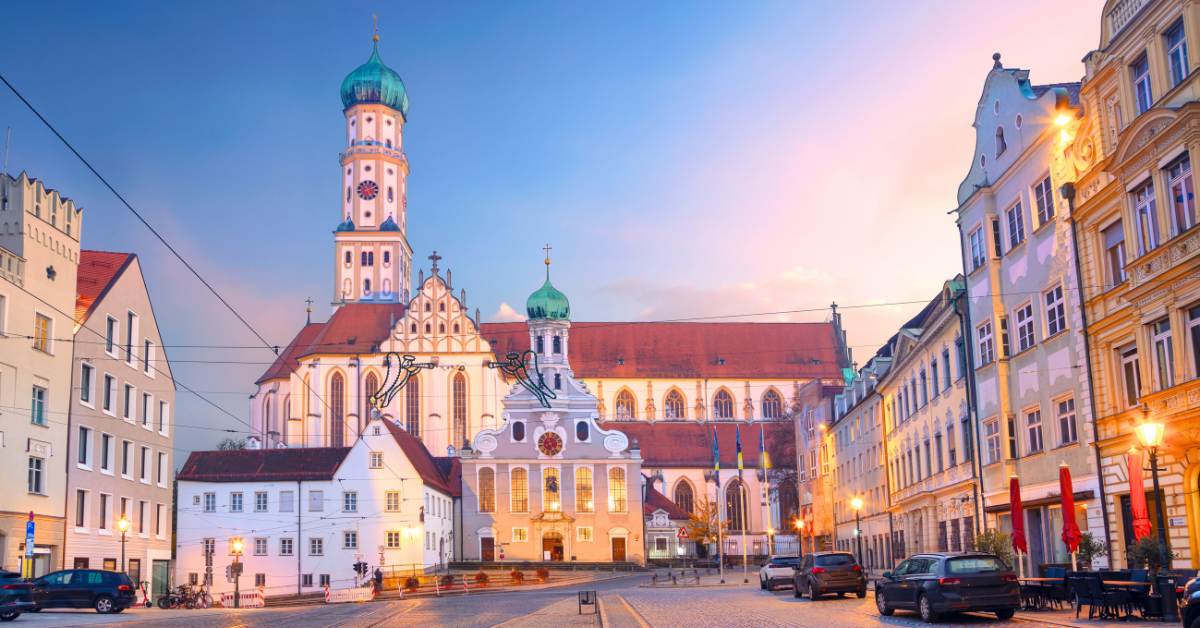
Visit Augsburg Botanical Gardens (Botanischer Garten Augsburg):
Satisfy your outdoorsy side and take some time to see the botanical gardens. These gardens are manicured to perfection and well taken care of. The cleanliness and bright, bold flowers, and clipped hedges will have you snapping photos every step of the way! One can get a map at the entrance, as this place is huge!
Spending hours in a serene and beautiful place like this is easy. There is a Japanese garden, an indoor terrace with towering palms, a relaxing picnic spot, and even a playground for the kids because, let's face it, kids aren't too crazy about trees these days.
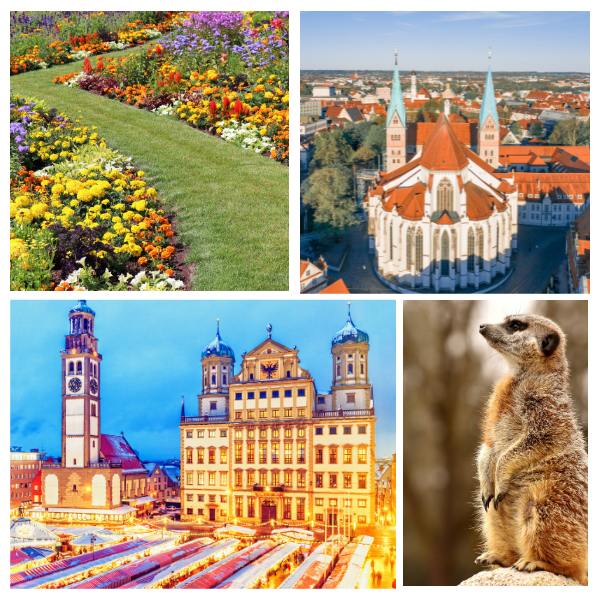
Visit the Augsburg Zoo:
A great stop in Augsburg for kids and adults who want to relive that childhood wonder. Get up close in person with animals from all around the world. The animals are very well taken care of and love visitors. See the cheeky elephants, lemurs, meerkats, reptiles, and more. Don't miss the aquatic shows, where you can learn all about the seals and watch them do their favorite tricks.
Visit The Mazda Museum (Automobil Museum Frey):
This Mazda museum displays hundreds of Mazdas from the years of evolution and informative tours in both German and English. The inclusiveness of the half-English displays and the array of amazing automobiles draw in huge crowds.
Be sure to read the signs! There are cars that aren't meant to be touched. A lot of these Mazdas are one of a kind. Oh, how embarrassing it would be to open the door of an ultra-rare Mazda and have the door just come off in your hand…
But if you're a respectful car enthusiast and want to see the classics and more, this museum is a must-see. It's a great opportunity for some amazing pics, too.
Schwangau & What to See
We've made it all the way to the most famous stop on the Romantic Road route, Schwangau in Bavaria.
Schwangau is most well-known for its yellow Hohenschwangau Castle and the fairy tale Neuschwanstein Castle tucked into the breathtaking Bavarian Alps.
Neuschwanstein is a fascinating place to see the history of ownership by King Ludwig II and the story of how the castle came to be. The stunning white towers can be spotted from miles away, and tours are offered throughout the day. Buy a ticket for your time slot and follow along with audio guides as you stroll the same halls as royalty once did. It's the experience of a lifetime and is a definite must when stopping in Schwangau.
Although Neuschwanstein is a huge part of Schwangau, there are so many other amazing things to do and see as well.
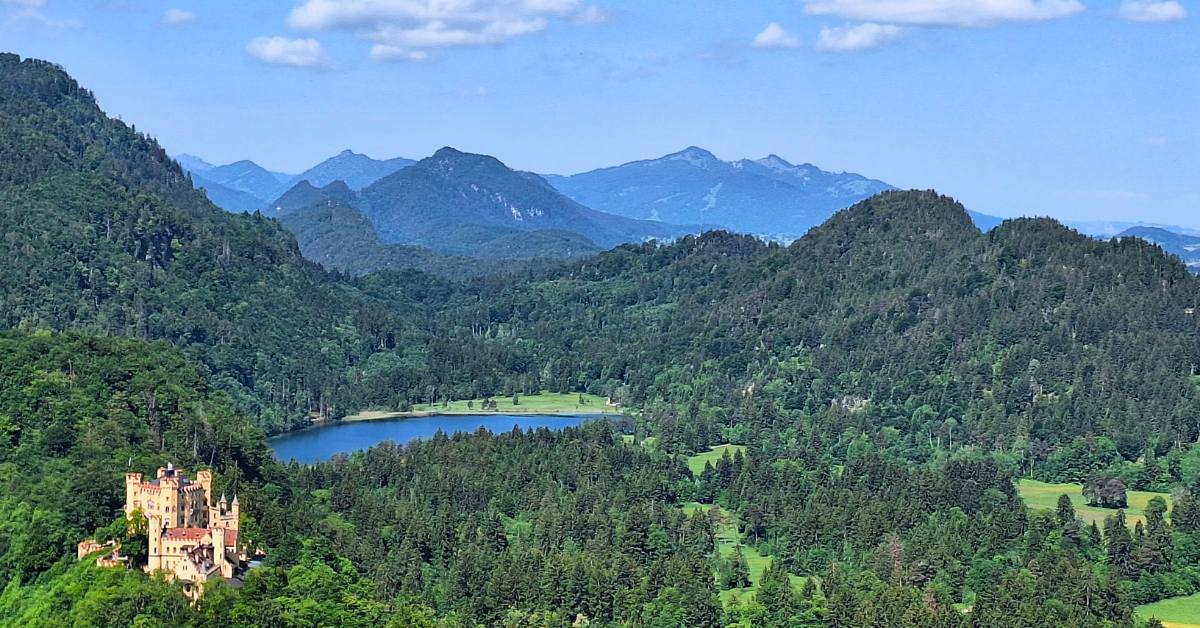
Visit Flugschule Aktiv:
Since Neuschwanstein is such an important part of tourism in Schwangau, there are so many activities geared around it. Here's one to cross off your bucket list. Paragliding off the Alps!
If there's one thing Schwangau has, it's scenery like no other. And what better way to see it all than from way up in the air, dangling from a parachute? It's not as scary as it sounds. Paragliding is a great way to satisfy the adrenaline junky you are deep down. Trust me. The take-off is the scariest part. From there, you can sit back and relax as you slowly glide by the towering Alps and castles below.
The highly qualified instructors are sure to inform you of everything you need to know and make the experience as comfortable and not so nerve-racking as possible. And don't worry, you won't jump alone. These paragliding experiences are tandem, meaning the instructor will go with you.
Open 9:00 am – 4:00 pm daily. Book your spot and have the time of your life!
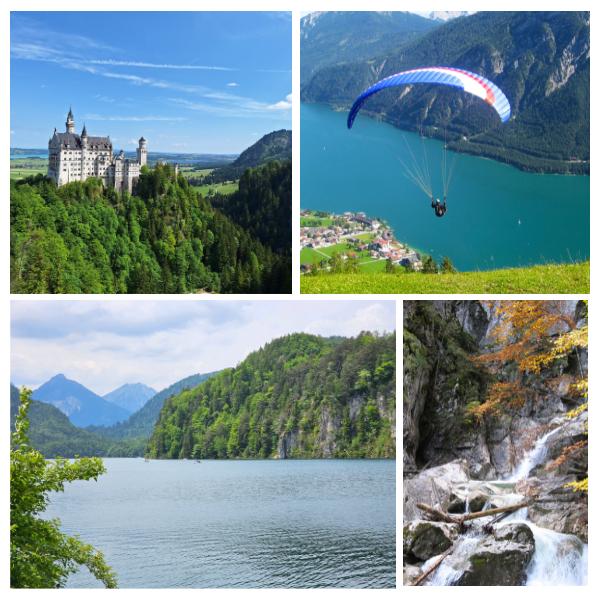 Schwangau is a great place for new adventures. Will paragliding be one of yours?
Schwangau is a great place for new adventures. Will paragliding be one of yours?Visit Pöllatschlucht Hiking Trails:
The hiking trail is great for nature lovers and offers a few ways to go with different terrain. The one path is paved and is easier with less incline for the more leisurely hikers. The other takes you into the valleys of the Alps and under Mary's Bridge. There are peaceful, jaw-dropping waterfalls and viewpoints as you follow the metal stairs leading along the mountain's edge. These are great photo opportunities!
Visit Tegelberg:
Located at the top of Mount Tegelberg, there is so much to do here to fill your afternoon. Take an inexpensive gondola to the top, where you'll be met with lovely cafés and restaurants serving different tastes from different states. Cakes, bratwursts and kaffees, oh my!
But that's not all. Mount Tegelberg features dozens of hiking trails to take in even more great views. On your way back down after a long day of photo snapping, might I suggest a better way to get down?
Release your inner child and throw your hands in the air, yelling 'WEEE' the whole way down on a massive slide. Tegelberg offers a huge bobsled-style chute to slide down. I mean, how could you pass on such a thing?
Things like these are hard to come by. And what better place to slide down a mountain than in Schwangau, the mountainous paradise.
We're nearing the end of the road, so with that, what do you think? Germany offers more than just cobblestones and beer, and the Romantic Road is a great way to see all the hidden gems and popular stops.
Will you be traveling the Romantic Road to see anything on the list?



























